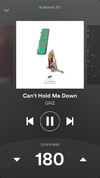Difference between revisions of "Cadence"
User:Fellrnr (User talk:Fellrnr | contribs) |
User:Fellrnr (User talk:Fellrnr | contribs) |
||
| (22 intermediate revisions by the same user not shown) | |||
| Line 1: | Line 1: | ||
| − | [[File: | + | [[File:ParisMarathonFeet 7737214 m.jpg|right|thumb|500px| Cadence is simply how often your feet touch the ground, but it has a profound impact on your [[Running Form]] and [[Running Economy]].]] |
| − | + | {{DISPLAYTITLE:Running Cadence}} | |
| − | = | + | Cadence is a critical part of running, lowering the stress on ankles, knees, & feet, improving [[Running Economy]], reducing injury rates, and enhancing [[Running Form]]. Cadence is how often your feet touch the ground and it's easy to modify. |
| − | Jack Daniels<ref name="jd"/> (the coach not the distiller) found that the slower the cadence, the longer you are in the air and the harder you land. Slow turn over means more impact, which causes more injury. | + | =Correct Cadence= |
| − | If you take this to the extreme ( | + | It's generally accepted that a turnover of 90 strides/minute is optimum for most people (180 steps/minute if counting both feet). To start off, check your cadence when you are running and if the number is 90 or higher, pat yourself on the back. If the number is lower than 90 then you should look at changing your cadence. Your cadence does not have to be exactly 90, and is likely to change somewhat with your pace and terrain. A faster pace may have a higher cadence, as will up or down hill sections. <br/><br/> |
| + | It's unclear if cadences above 90 strides/minutes are better or not. It's been observed that elite runners in a 5K have cadences of 95-100+<ref name="Treadlightly"/>, but those runners are moving at a much faster pace than most runners. The research discussed below suggests there is a "goldilocks zone" of optimal cadence, so it's reasonable that cadence could be too high for efficiency. It seems likely to me that the upper limit of efficient cadence is related to pace, but more research is needed in this area. | ||
| + | =Measuring Cadence= | ||
| + | The cheapest way is to measure your cadence is to simply count how many times your foot touches the ground in a minute. However, it's much easier to use a [[Best Running Watch| running watch]] that displays cadence. Some watches will use a small [[Footpod]] attached to your shoe, but others make use of an internal accelerometer. There's also more advanced options, such as [[RunScribe]] which make Footpods that measure a wide range of biomechanical data in addition to pace and [[Cadence]], including Braking G's, Impact G's, Ground Contact Time, [[Foot Strike]], and more. The accuracy of these approaches is covered in my [[Comparison of Cadence Monitors]]. | ||
| + | [[File:Cadence Comparison.jpg|none|thumb|500px|See my [[Comparison of Cadence Monitors]] for more details on the accuracy of [[Best Running Watch| watches that measure cadence]]. You'll find more detail, such as this comparison during a [[High Intensity Interval Training]] session.]] | ||
| + | =Changing Cadence= | ||
| + | There are several ways of changing your cadence. | ||
| + | * To increase your cadence, focus on smaller steps rather than running faster. Initially this will feel strange, but it will become natural with time. | ||
| + | * The easiest way to get the right cadence is to run with a metronome, which sets the pace for you. An example of a small metronome would be the [http://www.amazon.com/Seiko-DM50-Compact-Metronome-Blue/dp/B000B5MU4I Seiko DM50 Metronome]. I trained for several months with a similar device, and it helped me immensely. I found it rather loud, so I wrapped it in duct tape to quieten it down. | ||
| + | * A metronome app for a smartphone works and is cheaper, but verify that the app is accurate as there are reports of some that do not keep time correctly. | ||
| + | * Some [[Best Running Watch| running watches]] will display your cadence. The most common source for cadence is a [[Footpod]], but some Garmin watches can get cadence from the [[Heart Rate Monitor]] strap. The watches that provide cadence from an internal accelerometer tend to be less accurate than the other options, but it works if you make some allowances. The best watches will alert you if your cadence is out of the range you specify. See [[Best Running Watch]] for details on which watches have the functionality you want. | ||
| + | * You can [[Remixing Music For Running| remix music]] so that it is a higher tempo. | ||
| + | * If you run with a Smartphone, Spotify can detect your cadence and provide music with the right tempo. You can then adjust the tempo to match what you want your Cadence to be. I found the cadence detection to be pretty good and it's nice to have a wide selection of music that's the right tempo. Most of the time Spotify didn't seem to give me upbeat music, and I have better results with remixing music. Of course, the remix process is tedious and time consuming, so Spotify is much better than listening to music with the wrong beat. (This works on the free version of Spotify as well as the premium service, but only on the mobile app.)<br/> | ||
| + | {| class="wikitable" | ||
| + | |- valign="top" | ||
| + | |[[File:Spotify2.png|right|thumb|100px|Spotify detecting your cadence.]] | ||
| + | |[[File:Spotify1.png|right|thumb|100px|Spotify will allow you to adjust your target cadence in 5 BPM steps.]] | ||
| + | |} | ||
| + | * Having the correct [[Arm Position]] is important for maintaining your cadence. If your arms are too low it will be quite difficult to keep your cadence high. | ||
| + | * Lighter shoes tend to raise running cadence, probably due to the extra effort required to move a heavy shoe backwards and forwards. | ||
| + | =The Adaptation Process= | ||
| + | To start off, the change in cadence will feel very strange. I remember adjusting my cadence, and felt like my shoes were tied together! My steps were so short and fast that things felt all wrong. It took several weeks to adjust, but when the adjustment did take place, my running improved dramatically. I credit cadence as a key part of my success in going from a 4+ hour marathon to sub-3 hour and is one of my [[Running Breakthroughs]]. | ||
| + | =The Science of Running Cadence= | ||
| + | Jack Daniels<ref name="jd"/> (the coach not the distiller) found that the slower the cadence, the longer you are in the air and the harder you land. Slow turn over means more impact, which causes more injury. If you take this to the extreme ("Reductio ad Absurdum"), imagine running with just one step per minute. You would have to leap high in the so that you would be in the air for 30 seconds; the landing force would probably break your legs. | ||
| + | * Scientific studies have backed this up, showing that an increased cadence reduces the impact forces of running<ref name="Heiderscheit-2011"/><ref name="Mercer-2003"/> | ||
| + | * The peak impact force at a cadence of 88 being just over half that that of a cadence of 64<ref name="Hamill-1995"/>. | ||
| + | * A higher cadence also reduces peak leg deceleration as well as peak impact forces in the ankle and knee joints<ref name="Clarke-1985"/>. | ||
| + | * Higher cadence is also related to a reduction in [[Overstriding]]<ref name="Heiderscheit-2011"/>. | ||
| + | * A cadence of around 90 is also associated with greater [[Running Economy]] than lower or higher cadences<ref name="Hamill-1995"/>, though another study found 85 was optimal<ref name="LiebermanWarrener2015"/>. One problem with these studies is that they allow little or no time for the runner to adapt to the tested cadence, and I think this makes it probable that the detected Running Economy is not representative. | ||
| + | * Not surprisingly, a higher cadence reduces [[Delayed Onset Muscle Soreness]] and the associated weakness<ref name="RowlandsEston2001"/>. | ||
| + | * One study<ref name="WILLSON"/> showed that as people become tired, their cadence goes up, and with the higher cadence goes lower impact forces. Although a shorter stride/faster cadence results in less landing force, a longer stride length/lower cadence is associated with less of the impact force reaching the head<ref name="Mercer-2003"/>. | ||
| + | * The impact forces at a longer stride length are mostly absorbed by the knee<ref name="Derrick-1998"/>. | ||
| + | * Adding extra weight to the ankles of recreational runners did not change their Cadence or stride length at various speeds<ref name="Cavanagh-1989"/>. The study showed that Cadence remained nearly constant while stride length increased with speed, with or without weights of up to 1.1 kg/2.4 pounds. | ||
| + | * A review of the scientific studies showed consistently that an increased [[Cadence]] reduces shock at the hip, knee, and ankle, vertical oscillation, and ground contact time<ref name="SchubertKempf2013"/>. | ||
| + | * Barefoot running tends to have a higher cadence than shod<ref name="Divert-2005"/>. | ||
| + | * Leg Spring Stiffness increases with higher cadence<ref name="FarleyGonzález1996"/>. | ||
| + | * There is relatively little evidence concerning the height or leg length of athletes and their cadence. | ||
| + | ** A study of 37 male senior elite triathletes indicated that height did not change Cadence, but taller athletes were faster and had longer stride lengths <ref name="Brisswalter-1996"/>. | ||
[[File:Cadence and Impact.jpg|none|thumb|500px|This chart<ref name="Mercer-2003"/> shows the impact forces for three different cadences at the same speed. The thick line shows the Preferred Strike Frequency (PSF) and Preferred Strike Length (PSL), which was a cadence of 84. The thin line has the runners with a 10% slower cadence of 76 and shows increased impact. The dotted line shows 10% faster cadence of 93 and a reduced impact force.]] | [[File:Cadence and Impact.jpg|none|thumb|500px|This chart<ref name="Mercer-2003"/> shows the impact forces for three different cadences at the same speed. The thick line shows the Preferred Strike Frequency (PSF) and Preferred Strike Length (PSL), which was a cadence of 84. The thin line has the runners with a 10% slower cadence of 76 and shows increased impact. The dotted line shows 10% faster cadence of 93 and a reduced impact force.]] | ||
| − | [[File:Cadence and VO2.jpg|none|thumb|500px|A chart showing the oxygen cost and heart rate for different cadences. (Cadence values in red added)<ref name="Hamill-1995"/>. | + | [[File:Cadence and VO2.jpg|none|thumb|500px|A chart showing the oxygen cost and heart rate for different cadences. (Cadence values in red added)<ref name="Hamill-1995"/>. The highest cadence levels had impaired [[Running Economy]] but it should be noted the runners had relatively little time to adapt to the different values.]] |
| − | + | =References= | |
| − | |||
| − | |||
| − | |||
| − | |||
| − | |||
| − | |||
| − | |||
| − | |||
| − | |||
| − | |||
| − | |||
| − | |||
| − | |||
| − | |||
| − | |||
| − | |||
<references> | <references> | ||
<ref name="jd">[[Jack Daniels Running Formula]] (second edition) Page 93-94, "Stride Rate"</ref> | <ref name="jd">[[Jack Daniels Running Formula]] (second edition) Page 93-94, "Stride Rate"</ref> | ||
| Line 31: | Line 52: | ||
<ref name="Mercer-2003"> JA. Mercer, P. Devita, TR. Derrick, BT. Bates, Individual effects of stride length and frequency on shock attenuation during running., Med Sci Sports Exerc, volume 35, issue 2, pages 307-13, Feb 2003, doi [http://dx.doi.org/10.1249/01.MSS.0000048837.81430.E7 10.1249/01.MSS.0000048837.81430.E7], PMID [http://www.ncbi.nlm.nih.gov/pubmed/12569221 12569221]</ref> | <ref name="Mercer-2003"> JA. Mercer, P. Devita, TR. Derrick, BT. Bates, Individual effects of stride length and frequency on shock attenuation during running., Med Sci Sports Exerc, volume 35, issue 2, pages 307-13, Feb 2003, doi [http://dx.doi.org/10.1249/01.MSS.0000048837.81430.E7 10.1249/01.MSS.0000048837.81430.E7], PMID [http://www.ncbi.nlm.nih.gov/pubmed/12569221 12569221]</ref> | ||
<ref name="RowlandsEston2001">Ann V. Rowlands, Roger G. Eston, Caroline Tilzey, Effect of stride length manipulation on symptoms of exercise-induced muscle damage and the repeated bout effect, Journal of Sports Sciences, volume 19, issue 5, 2001, pages 333–340, ISSN [http://www.worldcat.org/issn/0264-0414 0264-0414], doi [http://dx.doi.org/10.1080/02640410152006108 10.1080/02640410152006108]</ref> | <ref name="RowlandsEston2001">Ann V. Rowlands, Roger G. Eston, Caroline Tilzey, Effect of stride length manipulation on symptoms of exercise-induced muscle damage and the repeated bout effect, Journal of Sports Sciences, volume 19, issue 5, 2001, pages 333–340, ISSN [http://www.worldcat.org/issn/0264-0414 0264-0414], doi [http://dx.doi.org/10.1080/02640410152006108 10.1080/02640410152006108]</ref> | ||
| − | <ref name="Heiderscheit-2011"> | + | <ref name="Heiderscheit-2011"> BC. Heiderscheit, ES. Chumanov, MP. Michalski, CM. Wille, MB. Ryan, Effects of step rate manipulation on joint mechanics during running., Med Sci Sports Exerc, volume 43, issue 2, pages 296-302, Feb 2011, doi [http://dx.doi.org/10.1249/MSS.0b013e3181ebedf4 10.1249/MSS.0b013e3181ebedf4], PMID [http://www.ncbi.nlm.nih.gov/pubmed/20581720 20581720]</ref> |
| + | <ref name="SchubertKempf2013">A. G. Schubert, J. Kempf, B. C. Heiderscheit, Influence of Stride Frequency and Length on Running Mechanics: A Systematic Review, Sports Health: A Multidisciplinary Approach, volume 6, issue 3, 2013, pages 210–217, ISSN [http://www.worldcat.org/issn/1941-7381 1941-7381], doi [http://dx.doi.org/10.1177/1941738113508544 10.1177/1941738113508544]</ref> | ||
| + | <ref name="Divert-2005">C. Divert, G. Mornieux, H. Baur, F. Mayer, A. Belli, Mechanical comparison of barefoot and shod running., Int J Sports Med, volume 26, issue 7, pages 593-8, Sep 2005, doi [http://dx.doi.org/10.1055/s-2004-821327 10.1055/s-2004-821327], PMID [http://www.ncbi.nlm.nih.gov/pubmed/16195994 16195994]</ref> | ||
| + | <ref name="Brisswalter-1996">J. Brisswalter, P. Legros, M. Durand, Running economy, preferred step length correlated to body dimensions in elite middle distance runners., J Sports Med Phys Fitness, volume 36, issue 1, pages 7-15, Mar 1996, PMID [http://www.ncbi.nlm.nih.gov/pubmed/8699842 8699842]</ref> | ||
| + | <ref name="Cavanagh-1989">PR. Cavanagh, R. Kram, Stride length in distance running: velocity, body dimensions, and added mass effects., Med Sci Sports Exerc, volume 21, issue 4, pages 467-79, Aug 1989, PMID [http://www.ncbi.nlm.nih.gov/pubmed/2674599 2674599]</ref> | ||
| + | <ref name="LiebermanWarrener2015">D. E. Lieberman, A. G. Warrener, J. Wang, E. R. Castillo, Effects of stride frequency and foot position at landing on braking force, hip torque, impact peak force and the metabolic cost of running in humans, Journal of Experimental Biology, volume 218, issue 21, 2015, pages 3406–3414, ISSN [http://www.worldcat.org/issn/0022-0949 0022-0949], doi [http://dx.doi.org/10.1242/jeb.125500 10.1242/jeb.125500]</ref> | ||
| + | <ref name="FarleyGonzález1996">Claire T. Farley, Octavio González, Leg stiffness and stride frequency in human running, Journal of Biomechanics, volume 29, issue 2, 1996, pages 181–186, ISSN [http://www.worldcat.org/issn/00219290 00219290], doi [http://dx.doi.org/10.1016/0021-9290(95)00029-1 10.1016/0021-9290(95)00029-1]</ref> | ||
| + | <ref name="Treadlightly">"Do All Elites Run at a 180 Cadence: None of the 5K Finalists at the US Olympic Trials Did" http://www.treadlightlybook.com/2012/07/do-all-elites-run-at-180-cadence-none.html</ref> | ||
</references> | </references> | ||
Revision as of 07:00, 23 March 2017
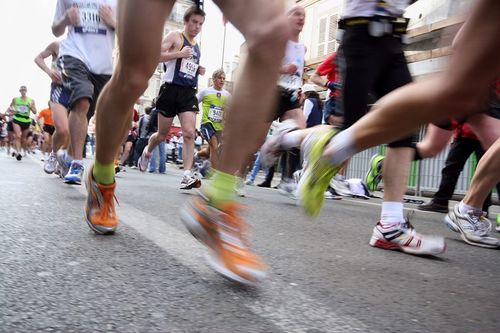
Cadence is a critical part of running, lowering the stress on ankles, knees, & feet, improving Running Economy, reducing injury rates, and enhancing Running Form. Cadence is how often your feet touch the ground and it's easy to modify.
Contents
1 Correct Cadence
It's generally accepted that a turnover of 90 strides/minute is optimum for most people (180 steps/minute if counting both feet). To start off, check your cadence when you are running and if the number is 90 or higher, pat yourself on the back. If the number is lower than 90 then you should look at changing your cadence. Your cadence does not have to be exactly 90, and is likely to change somewhat with your pace and terrain. A faster pace may have a higher cadence, as will up or down hill sections.
It's unclear if cadences above 90 strides/minutes are better or not. It's been observed that elite runners in a 5K have cadences of 95-100+[1], but those runners are moving at a much faster pace than most runners. The research discussed below suggests there is a "goldilocks zone" of optimal cadence, so it's reasonable that cadence could be too high for efficiency. It seems likely to me that the upper limit of efficient cadence is related to pace, but more research is needed in this area.
2 Measuring Cadence
The cheapest way is to measure your cadence is to simply count how many times your foot touches the ground in a minute. However, it's much easier to use a running watch that displays cadence. Some watches will use a small Footpod attached to your shoe, but others make use of an internal accelerometer. There's also more advanced options, such as RunScribe which make Footpods that measure a wide range of biomechanical data in addition to pace and Cadence, including Braking G's, Impact G's, Ground Contact Time, Foot Strike, and more. The accuracy of these approaches is covered in my Comparison of Cadence Monitors.
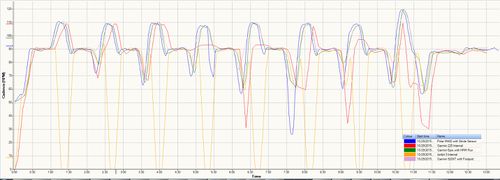
3 Changing Cadence
There are several ways of changing your cadence.
- To increase your cadence, focus on smaller steps rather than running faster. Initially this will feel strange, but it will become natural with time.
- The easiest way to get the right cadence is to run with a metronome, which sets the pace for you. An example of a small metronome would be the Seiko DM50 Metronome. I trained for several months with a similar device, and it helped me immensely. I found it rather loud, so I wrapped it in duct tape to quieten it down.
- A metronome app for a smartphone works and is cheaper, but verify that the app is accurate as there are reports of some that do not keep time correctly.
- Some running watches will display your cadence. The most common source for cadence is a Footpod, but some Garmin watches can get cadence from the Heart Rate Monitor strap. The watches that provide cadence from an internal accelerometer tend to be less accurate than the other options, but it works if you make some allowances. The best watches will alert you if your cadence is out of the range you specify. See Best Running Watch for details on which watches have the functionality you want.
- You can remix music so that it is a higher tempo.
- If you run with a Smartphone, Spotify can detect your cadence and provide music with the right tempo. You can then adjust the tempo to match what you want your Cadence to be. I found the cadence detection to be pretty good and it's nice to have a wide selection of music that's the right tempo. Most of the time Spotify didn't seem to give me upbeat music, and I have better results with remixing music. Of course, the remix process is tedious and time consuming, so Spotify is much better than listening to music with the wrong beat. (This works on the free version of Spotify as well as the premium service, but only on the mobile app.)
- Having the correct Arm Position is important for maintaining your cadence. If your arms are too low it will be quite difficult to keep your cadence high.
- Lighter shoes tend to raise running cadence, probably due to the extra effort required to move a heavy shoe backwards and forwards.
4 The Adaptation Process
To start off, the change in cadence will feel very strange. I remember adjusting my cadence, and felt like my shoes were tied together! My steps were so short and fast that things felt all wrong. It took several weeks to adjust, but when the adjustment did take place, my running improved dramatically. I credit cadence as a key part of my success in going from a 4+ hour marathon to sub-3 hour and is one of my Running Breakthroughs.
5 The Science of Running Cadence
Jack Daniels[2] (the coach not the distiller) found that the slower the cadence, the longer you are in the air and the harder you land. Slow turn over means more impact, which causes more injury. If you take this to the extreme ("Reductio ad Absurdum"), imagine running with just one step per minute. You would have to leap high in the so that you would be in the air for 30 seconds; the landing force would probably break your legs.
- Scientific studies have backed this up, showing that an increased cadence reduces the impact forces of running[3][4]
- The peak impact force at a cadence of 88 being just over half that that of a cadence of 64[5].
- A higher cadence also reduces peak leg deceleration as well as peak impact forces in the ankle and knee joints[6].
- Higher cadence is also related to a reduction in Overstriding[3].
- A cadence of around 90 is also associated with greater Running Economy than lower or higher cadences[5], though another study found 85 was optimal[7]. One problem with these studies is that they allow little or no time for the runner to adapt to the tested cadence, and I think this makes it probable that the detected Running Economy is not representative.
- Not surprisingly, a higher cadence reduces Delayed Onset Muscle Soreness and the associated weakness[8].
- One study[9] showed that as people become tired, their cadence goes up, and with the higher cadence goes lower impact forces. Although a shorter stride/faster cadence results in less landing force, a longer stride length/lower cadence is associated with less of the impact force reaching the head[4].
- The impact forces at a longer stride length are mostly absorbed by the knee[10].
- Adding extra weight to the ankles of recreational runners did not change their Cadence or stride length at various speeds[11]. The study showed that Cadence remained nearly constant while stride length increased with speed, with or without weights of up to 1.1 kg/2.4 pounds.
- A review of the scientific studies showed consistently that an increased Cadence reduces shock at the hip, knee, and ankle, vertical oscillation, and ground contact time[12].
- Barefoot running tends to have a higher cadence than shod[13].
- Leg Spring Stiffness increases with higher cadence[14].
- There is relatively little evidence concerning the height or leg length of athletes and their cadence.
- A study of 37 male senior elite triathletes indicated that height did not change Cadence, but taller athletes were faster and had longer stride lengths [15].
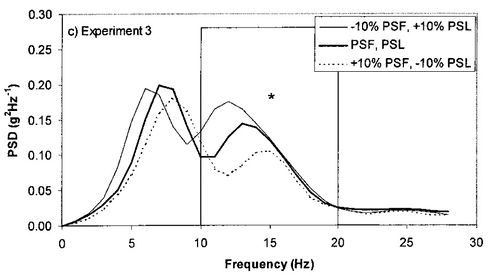
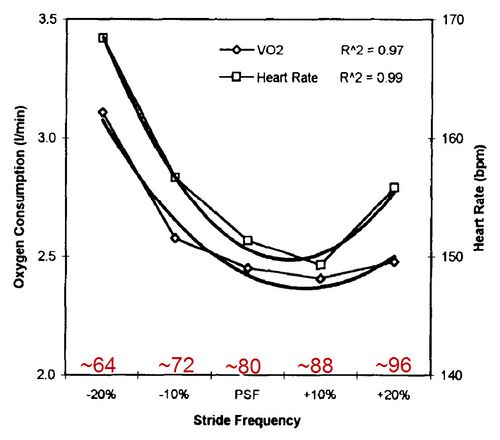
6 References
- ↑ "Do All Elites Run at a 180 Cadence: None of the 5K Finalists at the US Olympic Trials Did" http://www.treadlightlybook.com/2012/07/do-all-elites-run-at-180-cadence-none.html
- ↑ Jack Daniels Running Formula (second edition) Page 93-94, "Stride Rate"
- ↑ 3.0 3.1 BC. Heiderscheit, ES. Chumanov, MP. Michalski, CM. Wille, MB. Ryan, Effects of step rate manipulation on joint mechanics during running., Med Sci Sports Exerc, volume 43, issue 2, pages 296-302, Feb 2011, doi 10.1249/MSS.0b013e3181ebedf4, PMID 20581720
- ↑ 4.0 4.1 4.2 JA. Mercer, P. Devita, TR. Derrick, BT. Bates, Individual effects of stride length and frequency on shock attenuation during running., Med Sci Sports Exerc, volume 35, issue 2, pages 307-13, Feb 2003, doi 10.1249/01.MSS.0000048837.81430.E7, PMID 12569221
- ↑ 5.0 5.1 5.2 Hamill, J., T. R. Derrick, and K. G. Holt. "Shock attenuation and stride frequency during running." Human Movement Science 14.1 (1995): 45-60.
- ↑ TE. Clarke, LB. Cooper, CL. Hamill, DE. Clark, The effect of varied stride rate upon shank deceleration in running., J Sports Sci, volume 3, issue 1, pages 41-9, 1985, doi 10.1080/02640418508729731, PMID 4094019
- ↑ D. E. Lieberman, A. G. Warrener, J. Wang, E. R. Castillo, Effects of stride frequency and foot position at landing on braking force, hip torque, impact peak force and the metabolic cost of running in humans, Journal of Experimental Biology, volume 218, issue 21, 2015, pages 3406–3414, ISSN 0022-0949, doi 10.1242/jeb.125500
- ↑ Ann V. Rowlands, Roger G. Eston, Caroline Tilzey, Effect of stride length manipulation on symptoms of exercise-induced muscle damage and the repeated bout effect, Journal of Sports Sciences, volume 19, issue 5, 2001, pages 333–340, ISSN 0264-0414, doi 10.1080/02640410152006108
- ↑ http://journals.lww.com/acsm-msse/Abstract/1999/12000/Plantar_loading_and_cadence_alterations_with.20.aspx Plantar loading and cadence alterations with fatigue
- ↑ TR. Derrick, J. Hamill, GE. Caldwell, Energy absorption of impacts during running at various stride lengths., Med Sci Sports Exerc, volume 30, issue 1, pages 128-35, Jan 1998, PMID 9475654
- ↑ PR. Cavanagh, R. Kram, Stride length in distance running: velocity, body dimensions, and added mass effects., Med Sci Sports Exerc, volume 21, issue 4, pages 467-79, Aug 1989, PMID 2674599
- ↑ A. G. Schubert, J. Kempf, B. C. Heiderscheit, Influence of Stride Frequency and Length on Running Mechanics: A Systematic Review, Sports Health: A Multidisciplinary Approach, volume 6, issue 3, 2013, pages 210–217, ISSN 1941-7381, doi 10.1177/1941738113508544
- ↑ C. Divert, G. Mornieux, H. Baur, F. Mayer, A. Belli, Mechanical comparison of barefoot and shod running., Int J Sports Med, volume 26, issue 7, pages 593-8, Sep 2005, doi 10.1055/s-2004-821327, PMID 16195994
- ↑ Claire T. Farley, Octavio González, Leg stiffness and stride frequency in human running, Journal of Biomechanics, volume 29, issue 2, 1996, pages 181–186, ISSN 00219290, doi 10.1016/0021-9290(95)00029-1
- ↑ J. Brisswalter, P. Legros, M. Durand, Running economy, preferred step length correlated to body dimensions in elite middle distance runners., J Sports Med Phys Fitness, volume 36, issue 1, pages 7-15, Mar 1996, PMID 8699842

